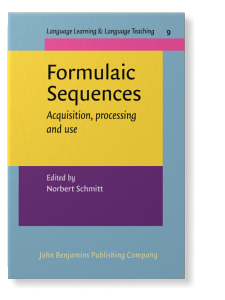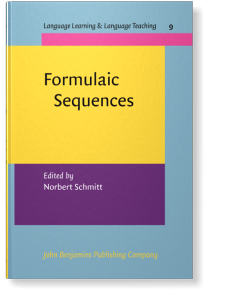Formulaic Sequences
Acquisition, processing and use
Editor
Formulaic sequences (FS) are now recognized as an essential element of language use. However, research on FS has generally been limited to a focus on description, or on the place of FS in L1 acquisition. This volume opens new directions in FS research, concentrating on how FS are acquired and processed by the mind, both in the L1 and L2. The ten original studies in the volume illustrate the L2 acquisition of FS, the relationship between L1 and L2 FS, the relationship between corpus recurrence of FS and their psycholinguistic reality, the processes involved in reading FS, and pedagogical issues in teaching FS. The studies use a wide range of methodologies, many of them innovative, and thus the volume serves as a model for future research in the area. The volume begins with three survey chapters offering a background on the characteristics and measurement of FS.
[Language Learning & Language Teaching, 9] 2004. x, 304 pp.
Publishing status: Available
© John Benjamins Publishing Company
Table of Contents
-
Preface | p. viii
-
Formulaic sequences in action: An introductionNorbert Schmitt and Ronald Carter | pp. 1–22
-
Measurement of formulaic sequencesJohn Read and I.S.P. Nation | pp. 23–35
-
Formulaic performance in conventionalised varieties of speechKoenraad Kuiper | pp. 37–54
-
Knowledge and acquisition of formulaic sequences: A longitudinal studyNorbert Schmitt, Zoltán Dörnyei, Svenja Adolphs and Valerie Durow | pp. 55–86
-
Individual differences and their effects on formulaic sequence acquisitionZoltán Dörnyei, Valerie Durow and Khawla Zahran | pp. 87–106
-
Social-cultural integration and the development of formulaic sequencesSvenja Adolphs and Valerie Durow | pp. 107–126
-
Are corpus-derived recurrent clusters psycholinguistically valid?Norbert Schmitt, Sarah Grandage and Svenja Adolphs | pp. 127–151
-
The eyes have it: An eye-movement study into the processing of formulaic sequencesGeoffrey Underwood, Norbert Schmitt and Adam Galpin | pp. 153–172
-
Exploring the processing of formulaic sequences through a self-paced reading taskNorbert Schmitt and Geoffrey Underwood | pp. 173–189
-
Comparing knowledge of formulaic sequences across L1, L2, L3, and L4Carol Spöttl and Michael McCarthy | pp. 191–225
-
The effect of typographic salience on the look up and comprehension of unknown formulaic sequencesHugh Bishop | pp. 227–248
-
‘Here’s one I prepared earlier’: Formulaic language learning on televisionAlison Wray | pp. 249–268
-
Facilitating the acquisition of formulaic sequences: An exploratory study in an EAP contextMartha Jones and Sandra Haywood | pp. 269–300
-
Index
“Second Language teachers and researchers have demonstrated a growing interest in formulaic language in recent years, and Schmitt's edited collection presents a welcome, stimulating range of studies on the acquisition and processing of formulaic sequences by L2 learners.”
Marian Rossiter, University of Alberta, in The Canadian Language Review 62(3), 2006
“This book can be read with some pleasure by most classroom teachers, and there is much that they, as well as scholars in applied linguistics, can learn from it.”
Bruce A. Beattie, Cleveland State University, in The Modern Language Journal Vol. 90(3), 2006
“This tome presents an interesting array of research that furthers our developing understanding of the acquisition and processing of formulaic sequences. Because it focuses predominantly on L2 learning, Schmitt's volume will be of considerable interest to both researchers and L2 educators. It makes a significant contribution to the field: the studies within it raise a myriad of complex questions to guide future studies on the acquisition and processing of formulaic sequences, and they encourage readers to consider a wider range of methods and contexts in their search for answers.”
Marian Rossiter, University of Alberta, in The Canadian Language Review 62(3), 2006
“The volume as a whole is a very accessible collection of papers that show a good range of empirical studies on the acquisition and processing of formulaic sequences.”
Cornelia Tschichold, University of Neuchatel, on Linguist List Vol. 15-2427, 2004
Cited by (173)
Cited by 173 other publications
Erman, Britt & Margareta Lewis
Gilquin, Gaëtanelle
Kyriacou, Marianna & Franziska Köder
Mäntylä, Katja, Anssi Roiha, Hannele Dufva & Heini-Marja Pakula
2024. Vocabulary learning in Finnish early foreign language learning textbooks. Language Teaching for Young Learners 6:1 ► pp. 84 ff. 
Agustín Llach, Maria Pilar
Altamimi, Abdulaziz & Kathy Conklin
Boone, Griet & June Eyckmans
DOĞAN, Nuh, Ahmet DAĞLI & Betül GÜVENDİ
EXARE, Christelle & Jacqueline VAISSIÈRE
Hennecke, Inga, Tatiana Perevozchikova & Evelyn Wiesinger
Hsu, Jeng-yih Tim & Su-han Cheng
2023. Teaching lexical collocations to enhance speaking proficiency of college English majors in Taiwan. AILA Review 36:2 ► pp. 231 ff. 
Nupponen, Anne-Maria, Sirpa Kärkkäinen & Päivi Björn
Wang, Qunfeng
Wolter, Brent
2023. Chapter 9. Cross-language influences in the acquisition of L2 multiword expressions. In Cross-language Influences in Bilingual Processing and Second Language Acquisition [Bilingual Processing and Acquisition, 16], ► pp. 211 ff. 
Zhang, Xiaofang & Barry Lee Reynolds
Zhou, Siyang & Jessica Briggs Baffoe-Djan
2023. “You just picked it up”. Study Abroad Research in Second Language Acquisition and International Education 8:1 ► pp. 142 ff. 
ÇUKURLU, Özlem & Gamze ERDEM
ÖZBAY, Ali Şükrü & Zehra GÜRSOY
Boone, Griet, Nicolas Ruytenbeek & Sofie Decock
Chen, Rachel S. Y.
Jiang, Ying
Kahng, Jimin
Ma, Qing, Jinlan Tang & Shanru Lin
Nguyen, Thao Thi Phuong & Louise Gwenneth Phillips
Park, Eunjeong
Wang, Jiayi & Nicola Halenko
Wang, Yuqi
Wang, Yuqi
Šarić, Antonija
Aline, David & Yuri Hosoda
Guo, Rundi & Nick C. Ellis
Negar Hasani & Adel Dastgoshadeh
Kho, Sharon Fung-Chien, Joseph Ramanair & Ambigapathy Pandian
Lee, Senyung & Sun-Young Shin
Pauwels, Paul
2021. Review of Randall (2007): Memory, Psychology and Second Language Learning. Language Learning and Language Teaching, Volume 19.. ITL - International Journal of Applied Linguistics ► pp. 138 ff. 
Sewbihon-Getie, Addisu
Shadrova, Anna, Pia Linscheid, Julia Lukassek, Anke Lüdeling & Sarah Schneider
Zafar, Shahila & Zaved Ahmed Khan
Zhang, Songshan, Hai Xu & Xian Zhang
Adolphs, Svenja, Dawn Knight, Catherine Smith & Dominic Price
Atashpanjeh, Alireza & Mehdi Haseli Songhori
Bui, Thuy, Frank Boers & Averil Coxhead
2020. Extracting multiword expressions from texts with the aid of online resources. ITL - International Journal of Applied Linguistics 171:2 ► pp. 221 ff. 
Khamkhien, Attapol & Sue Wharton
Lee, Binna & Diana Van Lancker Sidtis
Ma, Rong
Pan, Fan, Randi Reppen & Douglas Biber
2020. Methodological issues in contrastive lexical bundle research. International Journal of Corpus Linguistics 25:2 ► pp. 216 ff. 
Yan, Xun
YILMAZ, Nihan & Didem KOBAN KOÇ
Zhang, Xian
Abdollahpour, Zeinab & Javad Gholami
Babaei, Sarah, Siros Izadpanah & Gustavo Cunha Araújo
Paquot, Magali
Pellicer-Sánchez, Ana
Rafatbakhsh, Elaheh & Alireza Ahmadi
Römer, Ute & Cynthia M. Berger
Schmitt, Norbert, Suhad Sonbul, Laura Vilkaitė‐Lozdienė & Marijana Macis
Thomson, Haidee, Frank Boers & Averil Coxhead
Vilkaitė, Laura & Norbert Schmitt
Çubukçu, Feryal
ÇUBUKÇU, Feryal & Serkan TURAN
Awaj, Carima
Coxhead, Averil
Liontas, John I.
Mauranen, Anna
Nini, Andrea
Pan, Yi-Chun, Tzung-Hung Tsai, Yueh-Kuey Huang & Dilin Liu
Pérez Serrano, Mercedes
Rafieyan, Vahid
Sarygez, Ol'ga Vladimirovna
Verdaguer, Isabel & Judy Noguchi
2018. Identifying verb collocational patterns in a specialized medical journal corpus. Revista Española de Lingüística Aplicada/Spanish Journal of Applied Linguistics 31:2 ► pp. 660 ff. 
Allan, Rachel
Arnon, Inbal & Morten H. Christiansen
Bardovi-Harlig, Kathleen & David Stringer
Boers, Frank, Tu Cam Thi Dang & Brian Strong
Boers, Frank, Murielle Demecheleer, Lin He, Julie Deconinck, Hélène Stengers & June Eyckmans
Carter, Ronald & Michael McCarthy
Filippas, Apostolos
Filippas, Apostolos & Theodoros Lappas
Ruan, Zhoulin
Assassi, Tarek
Chen, Howard Hao-Jan, Jian-Cheng Wu, Christine Ting-Yu Yang & Iting Pan
Mirzaei, Azizullah, Masoud Rahimi Domakani & Sedigheh Rahimi
Mutlu, Gizem & Özlem Kaşlıoğlu
Römer, Ute
Stengers, Hélène, Julie Deconinck, Frank Boers & June Eyckmans
Wang, Lei & Chan Chen
WIECHMANN, DANIEL & ELMA KERZ
Alharthi, Thamer
Astruc, Lluïsa & Lina Adinolfi
Athira, U. & Sabu M. Thampi
Brook O'Donnell, Matthew, Ute Römer & Nick C. Ellis
2015. The development of formulaic sequences in first and second language writing. In Current Issues in Phraseology [Benjamins Current Topics, 74], ► pp. 83 ff. 
Cieślicka, Anna B.
Cieślicka, Anna B.
El-Dakhs, Dina Abdel Sala
Erman, Britt, Annika Denke, Lars Fant & Fanny Forsberg Lundell
Garnier, Mélodie & Norbert Schmitt
González Fernández, Beatriz & Norbert Schmitt
2015. How much collocation knowledge do L2 learners have?. ITL - International Journal of Applied Linguistics 166:1 ► pp. 94 ff. 
Gómez Burgos, Eric
Kashiha, Hadi & Swee Heng Chan
Krummes, Cedric & Astrid Ensslin
Olive, Thierry & Georgeta Cislaru
2015. Linguistic forms at the process-product interface. In Writing(s) at the Crossroads, ► pp. 99 ff. 
Pettitt, Nicole M. & Elaine Tarone
Siyanova-Chanturia, Anna
Titone, Debra, Georgie Columbus, Veronica Whitford, Julie Mercier & Maya Libben
Van Lancker Sidtis, Diana, JiHee Choi, Amy Alken & John J. Sidtis
Vetchinnikova, Svetlana
WOLTER, BRENT & JUNKO YAMASHITA
Arnon, Inbal & Uriel Cohen Priva
Boers, Frank, Murielle Demecheleer, Averil Coxhead & Stuart Webb
Edmonds, Amanda
Ghanbaran, Samira & Saeed Ketabi
Guz, Ewa
Guz, Ewa
Leńko-Szymańska, Agnieszka
2014. The acquisition of formulaic language by EFL learners. International Journal of Corpus Linguistics 19:2 ► pp. 225 ff. 
Lindstromberg, Seth & June Eyckmans
2014. How big is the positive effect of assonance on the recall of L2 collocations?. ITL - International Journal of Applied Linguistics 165:1 ► pp. 19 ff. 
Onoda, Sakae
Boers, Frank
Csomay, Eniko
Geluso, Joe
Karabacak, Erkan & Jingjing Qin
Lin, Yen-Liang
Molinaro, Nicola, Paolo Canal, Francesco Vespignani, Francesca Pesciarelli & Cristina Cacciari
YULDASHEV, AZIZ, JULIETA FERNANDEZ & STEVEN L. THORNE
Boers, Frank & Seth Lindstromberg
Gavins, Joanna & Peter Stockwell
Martinez, Ron & Norbert Schmitt
Nagy, William, Dianna Townsend, Nonie Lesaux & Norbert Schmitt
Van Moere, Alistair
Chen, Hao-Jan Howard
Konzett, Carmen
Laufer, Batia & Tina Waldman
SCHMITT, NORBERT, XIANGYING JIANG & WILLIAM GRABE
Tremblay, Antoine, Bruce Derwing, Gary Libben & Chris Westbury
DeKeyser, Robert
Durrant, Philip & Norbert Schmitt
Simpson-Vlach, Rita & Nick C. Ellis
Strik, Helmer, Micha Hulsbosch & Catia Cucchiarini
Bardovi‐Harlig, Kathleen
Kuiper, Koenraad, Georgie Columbus & Norbert Schmitt
LIU, DILIN & PING JIANG
Rossiter, Marian J.
Westhoff, Gerard J.
Wierzbicka, Anna
Conklin, Kathy & Norbert Schmitt
Conklin, Kathy & Norbert Schmitt
Cortes, Viviana
Driessen, Carla, Gerard Westhoff, Jacques Haenen & Mieke Brekelmans
ELLIS, NICK C., RITA SIMPSON‐VLACH & CARSON MAYNARD
Farr, Fiona
Lindstromberg, Seth & Frank Boers
Low, Graham
Schmitt, Norbert
Schmitt, Norbert
Eerdmans, Susan L. & Micaela Di Candia
GARDNER, DEE & MARK DAVIES
Taguchi, Naoko
Ellis, Nick C.
Ellis, Nick C.
Fitzpatrick, Tess & Alison Wray
Lessard-Clouston, Michael
Chan, Tun-pei & Hsien-Chin Liou
Crawford, William J.
[no author supplied]
This list is based on CrossRef data as of 18 july 2024. Please note that it may not be complete. Sources presented here have been supplied by the respective publishers. Any errors therein should be reported to them.
Subjects
Main BIC Subject
CF: Linguistics
Main BISAC Subject
LAN009000: LANGUAGE ARTS & DISCIPLINES / Linguistics / General

